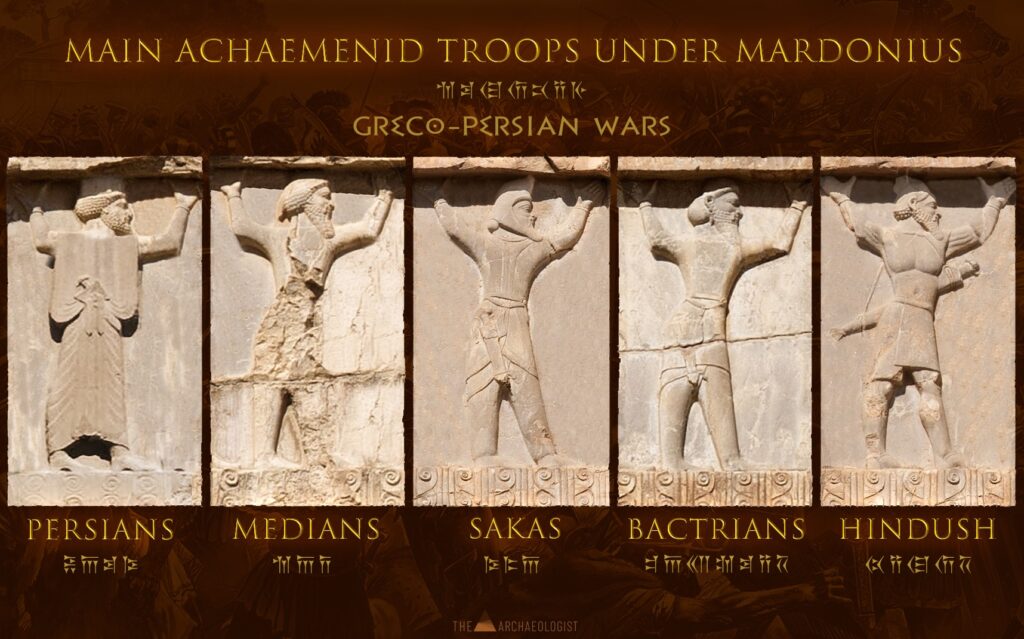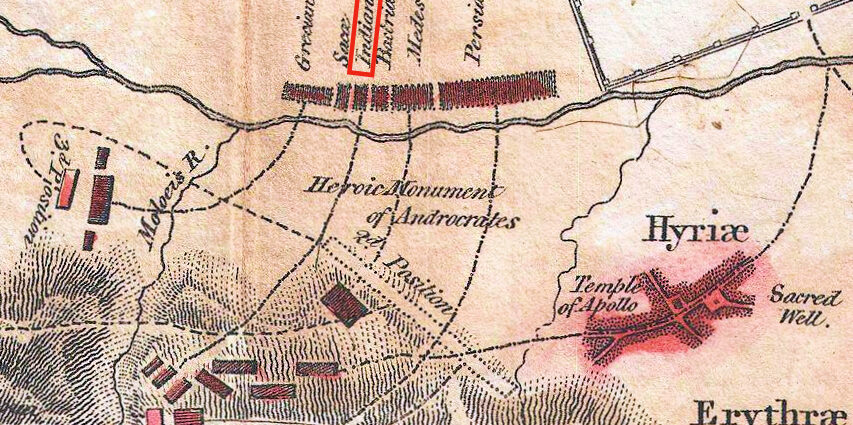Hindus have always been portrayed as a defensive and risk-averse community. They fought only when forced to do so, and as a result, they mostly ended up on the losing side. They never took the fight to the enemy’s camp and barring a few cases, they remained ensconced in their home only.
However, there were few battles in the past 2500 years where Hindus indeed took some action outside their region. Among such few occurrences, Hindus, at least twice, sided with Persians and even went as far as Greece to fight during the Second Persian-Greek Battle in 480 BCE.
Indians formed one of the main corps of Achaemenid (Persian) troops and even supplied soldiers and elephants to them. As a reward, they, along with others, were depicted on the tomb of Xerxes I at Naqsh-e Rostam in present-day Iran. They were differentiated by their loincloths, sandals, and exposed upper body, which set them apart from the soldiers of other regions such as Bactria and Arachosia.

Famous Greek Historian Herodotus stated that in the spring of 480 BCE, Indian troops marched with Xerxes’s army across the strait of Hellespont in the Mediterranean Sea. It was the “first-ever force from India to fight on the continent of Europe,” defeating Greek troops at the Battle of Thermopylae in 480 BCE and the final Battle of Platea in 479 BCE. The Indians participating in these battles were from the region of Afghanistan, bordering Persia. However, in these battles, Indians acted mostly as mercenaries as the Persians wielded leadership. The latter, on their part, did return the favour when they helped Chandragupta Maurya usurp the Magadh throne from Nand kings.

Indians continued to participate in the battles in which the Persians fought. They again sided with Persians against Alexander in 331 BCE, in which Greeks won handsomely. It was dubbed as revenge of Alexander for the debacle at the hands of Persians 160 years ago. The defeat sent Persians on the path of rapid decline from which there was no resurrection. Some one thousand years later, in 640 CE, Islam obliterated their very existence.
After defeating Persia, Alexander moved to India in 326 BCE where he had to fight Porus, a brave king of the relatively small province of Punjab. Plutarch (46 – 120 CE), a Greek historian, gave an interesting description of the battle:
As for the Macedonians, however, their struggle with Porus blunted their courage and stayed their further advance into India. For having had all they could do to repulse an enemy who mustered only twenty thousand infantry and two thousand horse, they violently opposed Alexander when he insisted on crossing the river Ganges also, the width of which, as they learned, was thirty-two furlongs, its depth a hundred fathoms, while its banks on the further side were covered with multitudes of men-at arms and horsemen and elephants.
After hearing about the mighty army of Nand Kings, Greek soldiers revolted and decided to stay put in Bactria (Today’s Afghanistan and Pakistan). Many Persians were said to have fled to India after the defeat at the hands of Alexander, where they contributed handsomely to evolving Indian art and architecture. However, their contribution is not recognised as much as that of the Greeks. Persians again had to escape to India after the Arabs issued a dreaded and always-effective fatwa in the mid-7th century: Convert, flee or die.
In the early 10th century, Hindu Shahi kings, Jaipala and Anandpala, attacked Ghazni territories in Afghanistan, which were theirs just a few years back. However, they could not reclaim their lands, mainly because of inferior equipment and strategy.
In another such case, Rajendra Chola carried out the naval attack on Srivijiya in Indonesia in 1025, which can be construed as the one and only true military conquest of foreign territory by a Hindu army. However, the victory had long repercussions, which later enabled Arabs to capture the Indonesian islands and establish Islam. Hindus had to flee to the nearby island of Bali to escape near annihilation.
Later, in the early 19th century, Maharaja Ranjit Singh attacked and captured some regions of Afghanistan and succeeded in bringing back the Kohinoor from the descendants of Abdali. However, neither the territories nor Kohinoor could be held for long.
In the First and Second World Wars, Indians went all over the world to fight on behalf of the British. However, these wars were not theirs. Though Gandhi and Nehru did make some customary feeble murmurs against the British orders, they were summarily rejected.
In 1948 and 1971, India defeated Pakistan comprehensively, but the then governments made a mess of the victories, and the clear wins converted into miserable defeats.
In between, they keep parroting such inane statements: Not a blade of grass grows there.
Written by Amit Agarwal, author of the bestsellers on Indian history titled “Swift horses Sharp Swords” and a “Never Ending Conflict”.
Follow me on Twitter @amit1119 and Instagram/ Facebook at amitagarwalauthor.
Kindly support our work by donating to Bharat Voice at https://rzp.io/l/5HCr6XZNU .
![]()
- How Hindu rituals spawned numerous advancements in science, maths and other arts - March 13, 2024
- Naga Sadhus and their fighting skills - February 20, 2024
- Lessons for India from the Israel-Palestine conflict - October 12, 2023

